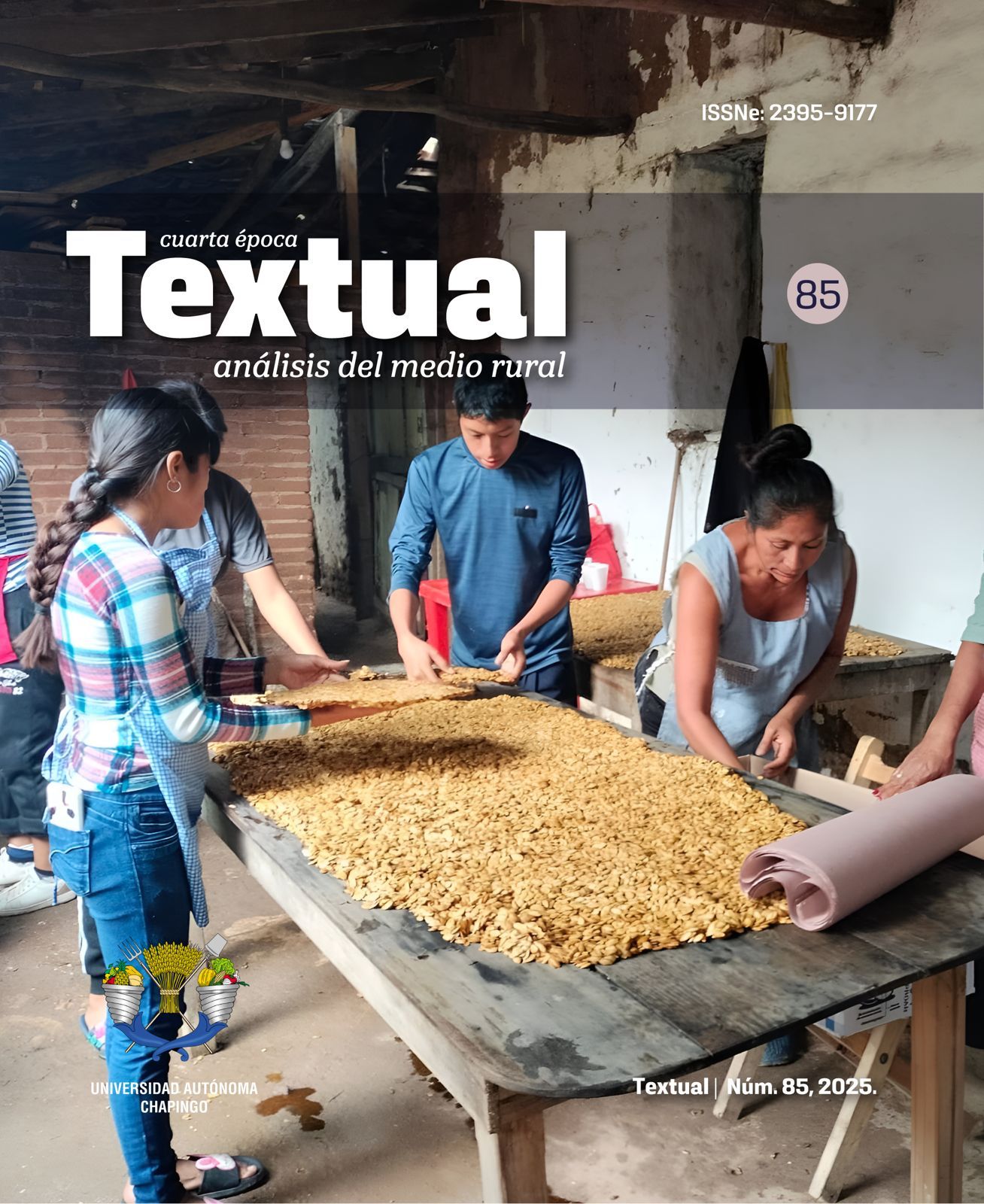Abstract
Social impact evaluation analyzes how a public program affects people´s lives to produce changes; it is based on a design that measures relevant variables for two equivalent groups: one exposed to the public intervention and the other without exposure. The objective of the research was to evaluate the impact of the national rural extension policy on the income of small-scale farm growers in 2015. A database with 1 083 records was used, of these, 58.5% were benefi and the rest were non- beneficiaries. The results from a log-level econometric model reveals that the rural extension policy increases the income of its beneficiaries by 16.8%, compared to an equivalent population that did not participate in the program. Income increases 4.7% for each additional year of beneficiaries’ education. The farmland scale and level of assets have a positive effect on the increase in income. The article concludes with a systematic assessment of the results aimed at recommendations based on lessons learned from evaluation as public management routine.
References
Danso, G., Ehiakpor, D., & Aidoo, R. (2018). Agricultural extension and its effects on farm productivity and income: insight from Northern Ghana. Agriculture & Food Security. 74(7):1-10. DOI: 10.1186/s40066018-0225-x
Davis, K., Nkonya, E., Kato, E., Mekonnen, D., Odendo, M., Miiro, R., & Nkuba, J. (2012). Impact of Farmer Field Schools on agricultural productivity and poverty in East Africa. World Development. 40(2):402- 413. DOI: 10.1016/j.worlddev.2011.05.019
Delgado, L., & Stoorvogel, J. (2022). Role of soil perception and soil variability by smallholder farmers in the low adoption rates of extension packages in Central America. Journal of Rural Studies. 93(2022):92-103. DOI: 10.1016/j.jrurstud.2022.05.009
Gamboa, L., & Waltenberg, F. (2012). Inequality of opportunity for educational achievement in Latin America: Evidence from PISA 2006-2009. Economics of Education Review. 31(5):694-708. DOI: 10.1016/j.econedurev.2012.05.002
Gao, Y., Zhao, D., Yu, L., & Yang, H. (2020). In-fluence of a new agricultural technology extension mode on farmers’ technology adoption behavior in China. Journal of Rural Studies. 76(1):173-183. DOI:10.1016/j.jrurstud.2020.04.016.
Godtland, E., Sadoulet, E., de Janvry, A., & Murgai, R. (2004). The impact of farmer field schools on knowledge and productivity A study of potato farmers in the Peruvian Andes. Economic Development and Cultural Change. 53(1):63-92. DOI: 10.1086/423253
Greene, W. (2012). Econometric analysis. Seventh Edition. Pearson. Edinburgh Gate, United Kingdom. 1238 p.
Jørs, E., Konradsen, E., Huici, O., Morant, R., Volk, J., & Lander, F. (2016). Impact of training bolivian farmers on integrated pest management and diffusion of knowledge to neighboring farmers. Journal of Agromedicine. 21(2):200-208. DOI: 10.1080/1059924X.2016.1143428
Keller, K., Landini, F., Rojas, R., & Prosser, B. (2021). Facilitadores y obstaculizadores de la implementación de un programa de extensión rural chileno: estudio cualitativo de la adherencia y las competencias del extensionista rural. Cuadernos de Desarrollo Rural. 18(2021):1-21. DOI: 10.11144/Javeriana.cdr18.foip
Läpple, D., & Hennessy, T. (2015). Assessing the impact of financial incentives in extension programmes: Evidence from Ireland. Journal of Agricultural Economics. 66(3):781-795. DOI: 10.1111/14779552.12108
Lioutas, E., Charatsari, C., Cernic, M., La Rocca, G., & De Rosa, M. (2019). The challenges of setting up the evaluation of extension systems by using a systems approach: the case of Greece, Italy and Slovenia. The Journal of Agricultural Education and Extension. 25(2):139-160. DOI: 10.1080/1389224X.2019.1583818
Lyne, M., Nomonde, J., & Ortmann, G. (2017). A quantitative assessment of an outsourced agricultural extension service in the Umzimkhulu District of KwaZulu-Natal, South Africa. The Journal of Agricultural Education and Extension. 24(1):51-64. DOI: 10.1080/1389224X.2017.1387159
Preissing J., Ardilla S., Buitrón J., & Fernández C. (2014). Nuevas inversiones en extensión para la agricultura familiar. In: Agricultura familiar en América Latina y el Caribe: Recomendaciones de política. Salcedo, S. y Guzmán, L. (eds.). Primera Edición. Organización de las Naciones Unidas para la Alimentación y la Agricultura. Chile. 215-231 pp.
Rendón, R., Roldán, E., Hernández, B., & Cadena, P. (2015). Los procesos de extensión rural en México. Revista Mexicana de Ciencias Agrícolas. 6(1):151-161. DOI: 10.29312/remexca.v6i1.746
Santos, V., Arana, O., Martínez, M., Garza, L., Mora, J., & Santoyo, H. (2023). Determinantes de la innovación agrícola entre pequeños agricultores en México. Una aplicación econométrica del Modelo Tobit. Agrociencia. 57(2): 339-368. DOI: 10.47163/agrociencia.v57i2.2878
Secretaría de Agricultura, Ganadería, Desarrollo Rural, Pesca y Alimentación (SAGARPA). (2017). Compendio de indicadores de gestión y resultados 2015. Componente de Extensión e Innovación Productiva del Programa Integral de Desarrollo Rural. México. SAGARPA. 85 p.
Stasinopoulos, M., Rigby R., Heller G., Voudouris V., & De Bastiani, F. (2017). Flexible Regression and Smoothing using GAMLSS in R. Taylor & Francis Group. A Chapaman & Hall Book. United States of America, 2017. 550 p. DOI: https://doi.org/10.1201/b21973
Soriano, P., Castillo, M., Córdoba, O., & Mansilla. R. (2017). Non-stationary individual and household income of por, rich and middle classes in Mexico. Physica A: Statistical Mechanincs and its Applications. 465(1):403-413. DOI: 10.1016/j.physa.2016.08.042
Tilak, J. (2010). Education and poverty. Journal of Human Development. 3(2):191-207. DOI: 10.1080/14649880220147301
Weiss, C. (2015). Preparando el terreno. In: Antología sobre evaluación. La construcción de una disciplina. Maldonado, C. y Pérez,
C. (coords.). Primera Edición. Centro de Investigación y Docencia Económicas, A. C., Centro CLEAR para América Latina. México. 43-83 pp.
Wooldridge, J. (2015). Introducción a la econometría. Quinta Edición. CENGAGE Learning Editores S.A. de C.V. México. 878 p.

This work is licensed under a Creative Commons Attribution-NonCommercial 4.0 International License.
Copyright (c) 2024 Victor Manuel Santos Chávez, Adolfo Guadalupe Álvarez Macías, Miguel Ángel Martínez Damián, Humberto Vaquera Huerta, Oscar Antonio Arana Coronado, Vinicio Horacio Santoyo Cortés




